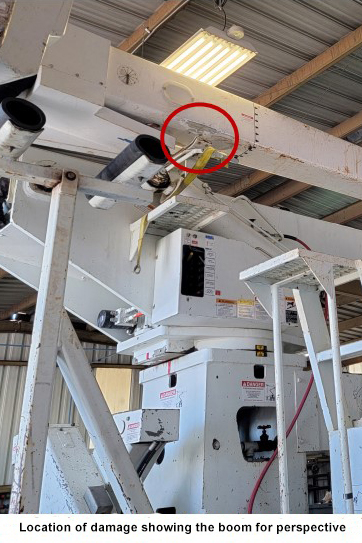Maintaining Your Insulated Booms: Part 2 - Photographing Major Fiberglass Damage
In this four-part series, Utility Pros will summarize and share four Tech Tips produced by our Product Support Team. Tech Tips cover the most common questions our Terex Services Team receives regarding repairs and replacements and is meant to provide service personnel with information to make their jobs easier. In this series, we cover tips related to maintaining insulated booms, including:
Correctly taking photos of the damage,
Performing maintenance on the caulking or sealant at the fiberglass to steel joint, and
Documenting the Damage
Major damage to an insulated boom must be reported to the manufacturer for analysis to determine if it can be repaired. To receive the appropriate support and possible repairs from the Terex Services team, it is important to take quality photos that depict the damage the most accurate way. Tech Tip 84 covers the best practices for taking photos of fiberglass damage.
When taking pictures of fiberglass damage, it is important to have the right tools handy. Besides a camera, be sure to have:
Sander
Measuring Tape/Ruler
Depth Gauge
Paint Marker
Colored Tape
Photographic Tips to Follow:
Getting good quality photos will improve response times and minimize the need for retakes.
If taking pictures with a phone, check the settings to make sure image resolution is high and file type is compatible. JPEG images are preferred. (Note iPhones in particular may take photos in HEIF/HEVC, which is not compatible.)
Mark the area on the boom with colored tape to help identify the area of damage.
Take multiple pictures from multiple angles and distances, including a far-away shot of the entire boom and a close up shot.
Include measurements to provide a reference point of the location of the damage on the boom. Either write on the boom with a paint marker or draw a picture with the measurements. Do not include depth indicators or measuring tapes in the photo as it produces glare, and a poor-quality photo.
Horizontal shots are preferred to vertical shots.
Make sure the damage is in focus. Use a tripod if necessary.
Download and review the photos on your computer before sending to verify if they are in focus.
It is best to send the photos as an attachment in an email rather than embedding in the body of the email.
When emailing pictures, most email systems limit the number and size of attachments. You may want to save all files in a zipped folder or other shareable folder such as a Dropbox link.
Read Tech Tip 84 for more suggestions on getting the best photo and most accurate record of the fiberglass damage.
Related Posts

Maintaining Your Insulated Booms: Part 1 – Understanding the Extent of Damage
In this four-part series, Utility Pros will summarize and share four Tech Tips produced by our Product Support Team. Tech Tips cover the most common questions our Terex Services Team receives regarding repairs and replacements and is meant to provide...
Continue Reading

Maintaining Your Insulated Booms: Part 3 – Maintenance of Fiberglass to Steel Joint
One of the most common fiberglass maintenance points on a unit is the caulking or sealant at the fiberglass to steel joint. Improperly maintained joints can lead to corrosion of the steel boom section, moisture and...
Continue Reading

Maintaining Your Insulated Booms: Part 4 – Repairing and Refinishing Fiberglass Booms
Damage to the booms outer gel-coat can reduce the dielectric strength of the fiberglass. Tech Tip 149 covers procedures in repairing small areas of gel coat surface damage. Before making any gel coat repairs...
Continue Reading

.png?sfvrsn=cfc0900d_0)
